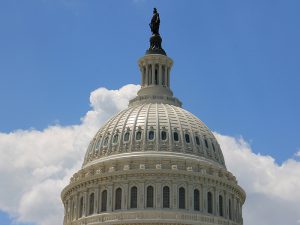
Bipartisan group of lawmakers releases roadmap for revitalizing U.S. maritime
Written by Marine Log Staff
Senator Mark Kelly: “After decades of neglect, revitalizing the American maritime industry will supercharge our economy and strengthen our national security.”
Senator Mark Kelly (D-Ariz.) and Representative Mike Walz (R.-Fla.) along with Senator Marco Rubio (R.-Fla,) and Representative John Garamendi (D-Calif.), have released a roadmap for revitalizing the U.S. maritime sector. Entitled “Congressional Guidance for a National Maritime Strategy” it provides a comprehensive vision for planning guidance, strategic objectives, and actionable steps to revitalize the U.S. maritime sector.
The legislators believe that, in an era of great power competition, aging infrastructure, and the threat of high intensity war, Congress must adopt a maritime strategy vital to U.S. national security and the world.
Unfortunately, they say, despite calls from Congress for the last decade, such a comprehensive strategy has yet to be produced.
Roadmap for revitalizing U.S. maritime sector
“After decades of neglect, revitalizing the American maritime industry will supercharge our economy and strengthen our national security,” said Sen. Kelly, a U.S. Merchant Marine Academy graduate and Navy veteran. “Our bipartisan report provides a roadmap for the administration and Congress to work together to rebuild our shipbuilding sector and fortify the U.S.-flag fleet. It won’t be easy, but America has always been a maritime nation—and the stakes are too high for us to fail.”
“The United States desperately needs to modernize its maritime capabilities to compete with China’s rapidly growing navy and ensure the freedom of international seas,” said Rep. Waltz. “I’m proud to work with my colleagues across the aisle to revitalize our shipping sector and strengthen our national security.”
“As China vies for global influence, the United States must project strength and security in the maritime domain,” said Sen. Rubio. “Congress must act swiftly to adopt a maritime strategy that invests in our industrial base, reestablishes a strong workforce, and strengthens our national security.”
“Congress and the U.S. military must rebuild our domestic commercial shipbuilding and maritime industrial base so we can continue to project American sea power abroad during peacetime or war,” said Rep. Garamendi. “American shipyards and mariners are ready, willing, and able to do the job but can no longer be expected to compete against heavily subsidized foreign competitors in mainland China and elsewhere. Our maritime strategy must support American manufacturing and correct our nation’s longstanding trade imbalance with foreign countries.”
Earlier this year, Sen. Kelly and Rep. Waltz led a bipartisan, bicameral letter urging President Biden to strengthen the United States’ maritime power. The group of legislators called on him to establish an interagency maritime policy director, designate maritime infrastructure as “critical infrastructure,” invoke the Defense Production Act for shipbuilding, and develop a whole-of-government maritime “de-risking” strategy to reduce dependency on Chinese maritime infrastructure and industry.
Sen. Kelly earned his B.S. degree in marine engineering and nautical science from the United States Merchant Marine Academy (USMMA) and later an M.S. degree in aeronautical engineering from the United States Naval Postgraduate School. Sen. Kelly spent 25 years in the United States Navy as a pilot and is the first ever USMMA alumnus to serve in Congress. Last year, Sen. Kelly was elected chair of the USMMA Board of Visitors for the 118th Congress.
The lawmakers’ roadmap revitalizing U.S. maritime lists 10 things that they say Congress can do now:
1 Speed development of a long-term National Maritime Strategy for incremental implementation, including state and local policy options. Establish a Presidentially appointed position to synchronize all national maritime affairs and policy. Establish a National Maritime Council, led by the President’s maritime appointee, to monitor and report on the implementation of the national maritime strategy.
2 Take all measures possible to expand, develop, and protect the domestic maritime workforce, fully funding and reinvigorating the Maritime Administration, U.S. Coast Guard, Federal Maritime Commission, and other federal agencies that protect, regulate, and support the U.S. maritime industry. Commission a national marketing campaign, implement workforce accelerators, including through international personnel exchanges, and champion the domestic maritime workforce, the U.S. Merchant Marine Academy, and our state maritime academies.
3 Grow domestic shipbuilding capacity and demand modern performance expectations. Provide the authorities and funding to support domestic shipbuilding. Explore treaty ally collaboration to expand domestic shipbuilding opportunities and insource capabilities to the U.S. market. ;
4 Grow U.S.-flagged shipping capacity and guarantee U.S. Government cargo during peacetime. Establish new programs leveraging a range of tools such as tax incentives, enhanced cargo preference, operational subsidization, and federal financing to incentivize companies to ship their products via U.S.-flagged vessels, with the aim of growing the U.S.-flagged international fleet’s size and carrying capacity
5 Urge investment in America’s Maritime Transportation System and inland waterways. Address the national maintenance backlog, which according to the American Society of Civil Engineers, amounts to $125 billion for bridges, $163 billion for ports, and $6.8 billion for inland waterways.
6 Create innovation incubator programs partnered with industry to lead the world in innovative and advanced nuclear energy solutions for the maritime sector. Fund modern design and production approaches, automation advances with human teaming, and applied research for materials, fuels, and energy.
7 Conduct assessments of economic, political, and military factors that threaten U.S. interests in the rapidly changing Polar Regions. Prepare and plan for potential competition for resources that may result from increased activity by U.S. adversaries in the Polar Regions, while respecting the rule of law and national sovereignty.
8 Provide the resources necessary to ensure our Naval forces can defend the freedom of the seas. Prioritize forward presence, readiness, and combat logistics. Provide multi-year authorizations for critical maritime programs and identify dedicated revenue sources to support critical maritime security and naval shipbuilding support programs.
9 Implement rules, policies, and resource decisions to de-risk the U.S. maritime sector from our strategic competitors. Evaluate and mitigate ways in which the U.S. has dependencies on strategic competitors and prioritize domestic capabilities.
10 Consistent with the U.S. National Security Strategy, advance the rule of law, allies and partners, trade, quality of life, and universal access to the global commons all unalienable American values. Express dedication to these fundamental principles by securing extended authorizations and appropriations for vital maritime programs that are crucial to both our economic and national security via maritime strength.
See the complete roadmap for revitalizing U.S. maritime




